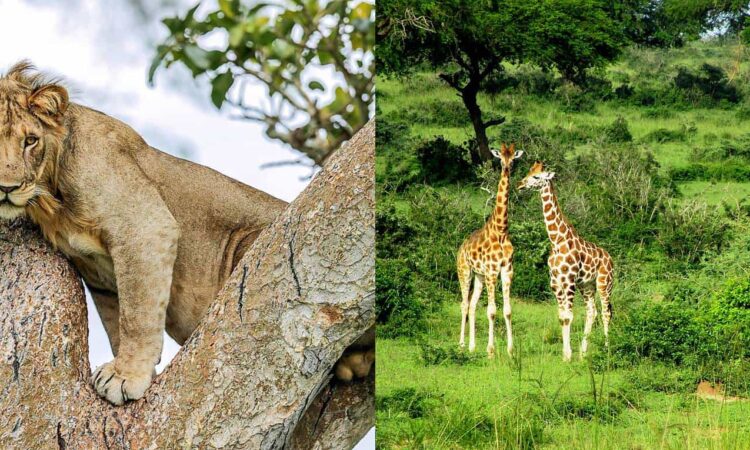Wildlife Safaris in Uganda: Safaris in Uganda typically visit all 10 of the country’s national parks. The national parks that provide the habitat to the wildlife species living together in harmony in their environment have been safeguarded and protected by the Uganda Wildlife Authority.

Ecosystem resilience principles state that nature must be able to sustain itself in the absence of human interference. As a result, even the populations of wildlife are maintained, which is why in Uganda, the wildlife includes both predators and prey, and any creatures that are not eaten by other animals perish from old age or sickness.
For instance, herbivores like elephants, impalas, and zebras, among others, eat grass. When the grass in one area becomes extinct, these animals move to a different location, where they will return to find the grass has grown. At the same time, carnivores like lions and leopards, which consume fresh meat, are actively hunting these herbivores, including elephants, zebras, and impalas, for food.
Long-term, as the herbivores consume the grass and the carnivores hunt the herbivores for food, the carnivores contribute to the maintenance of the national park’s carrying capacity by reducing the population of herbivorous animals, which serve as prey for the carnivores’ predatory nature. If the predators are not killed by humans, they perish from natural disasters like disease and death. The entire process is what is known to as nature’s eco-system resilience, and at some point humans also contribute to this resilience by engaging in activities like poaching, hunting, and fetching.
Where can I go on a wildlife safari in Uganda?
The following wildlife species, which may be found in Uganda’s conserved and protected natural environments, are found there:
The Murchison Falls National Park, the largest national park in the nation, will be visited as part of your Uganda wildlife safaris. It is home to the Karuma Falls, Murchison Falls, and Albert River Nile, which flows through the park on its way to South Sudan.
Since black rhinos became extinct in the area owing to past wars and poachers, you will have the opportunity to monitor the surviving white rhinos in Uganda when you visit Murchison Falls National area. In Murchison Falls National Park, visitors will also have the chance to take part in chimpanzee trekking in the Budongo forest.
The is incredibly fortunate to have a wide variety of wild creatures, which may be seen when on a game drive in the park. The game drive will give you a chance to see the big five wildlife creatures, including elephants, rhinos, leopards, lions, and buffaloes, in Murchison National Park, which will add to the excitement of your Uganda safari.
Hippos on the banks of the Albertine Nile, impalas, elands, baboons, and rare pates monkeys are among the numerous wildlife species found in the park. It is also well-known for its giraffe population, however these animals may also be seen in Queen Elizabeth National Park.
More than 5,000 bird species, including the shoe bill, may be seen in the park, providing visitors to Uganda on a wildlife safari with the chance to go bird watching. While taking a boat cruise trip on the Nile River, you may view certain wildlife creatures and bird species that will offer you a better understanding of how to appreciate the top of the falls, hippos, and crocodiles, among other things.
In addition to offering fantastic mountain gorilla trekking safaris, Bwindi Impenetrable Forest National Park is one of Uganda’s top spots for wildlife safaris and, being the country’s largest park, it has a lot to offer all visitors.
The best place to go on a Uganda wildlife safari is Queen Elizabeth National Park, where you can see lions that can climb trees, enjoy the breeze from the crater lakes, go birding on a boat cruise through the Kazinga Channel, which separates Lakes Edward and George, and see hippos, elephants, giraffes, zebras, impalas, and elands, among other animals, while going on a game drive adventure through the park.
The Queen Elizabeth is the second-largest and is situated in the Kasese area of southwest Uganda. Travelers may link to Bwindi Impenetrable Forest National Park through Queen Elizabeth National Park from the Mweya Peninsular through the Ishasha sector to experience mountain gorilla trekking while on a Uganda wildlife safari.
Other national parks that can contribute to an amazing Uganda safari include the Kidepo Valley National Park in northern Uganda, the mountain Ruwenzori National Park, the mountain Elgon National Park, the Semiliki National Park, and Kibale National Park, which is home to chimpanzees, golden monkeys, white and black mangabeys, among other primate species and bird species.
When is the best time for a Wildlife Safari in Uganda?
There is a best advised season to experience the wildlife excursions in their natural surroundings, even though Uganda wildlife safaris are conducted all year long. The rainy season and the dry season, which we experience in Uganda throughout the year, have an impact on the number of tourists visiting the nation.
The ideal time to go is during the dry season when it is simple to drive over the dusty road trails, hiking in the Bwindi forest is also simple since tourists may hike mountain gorillas and chimpanzees, and the roads are passable.
The long dry season lasts from June to October, and the short dry season lasts from December to February. While the animals are often hidden in the forest during the rainy season in the months of March, April, May, and November, the roads and trekking routes are wet, muddy, and slippery, making hiking challenging for those who are not physically strong. Therefore, in order to fully enjoy their Uganda wildlife safari journey, we advise visitors to go there during the dry season.


